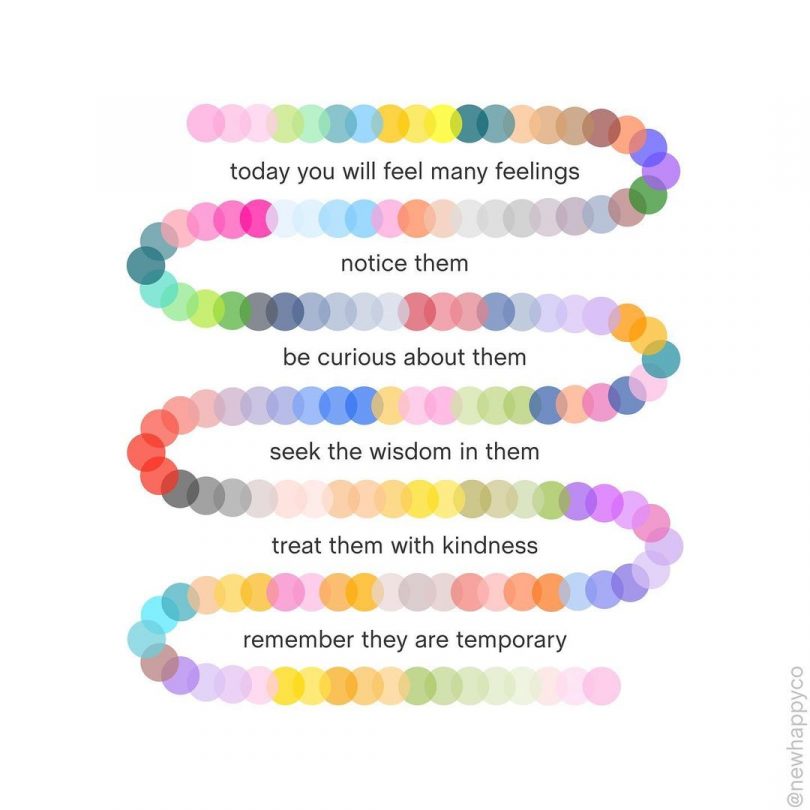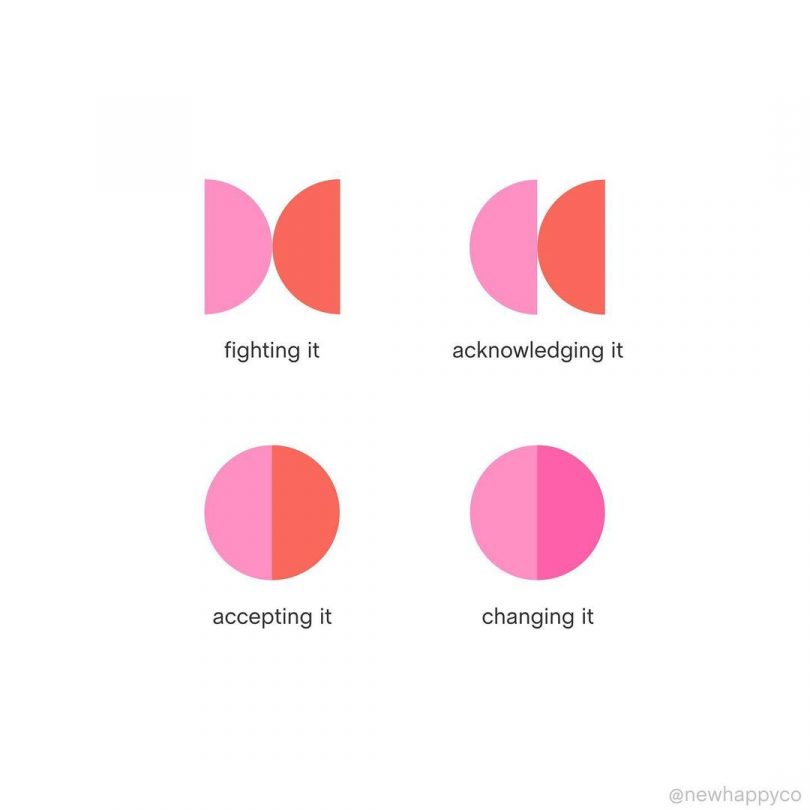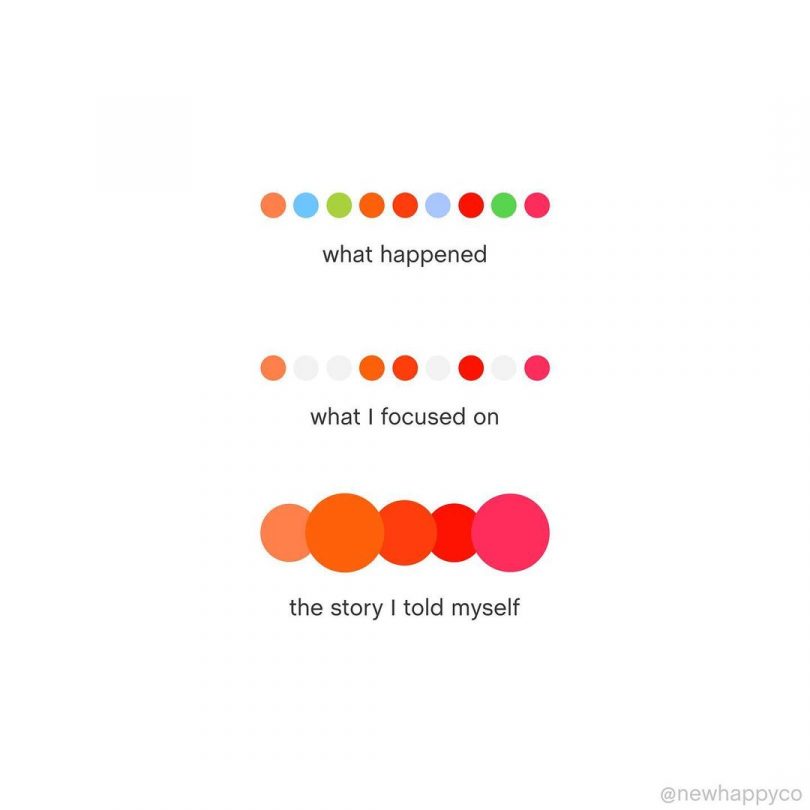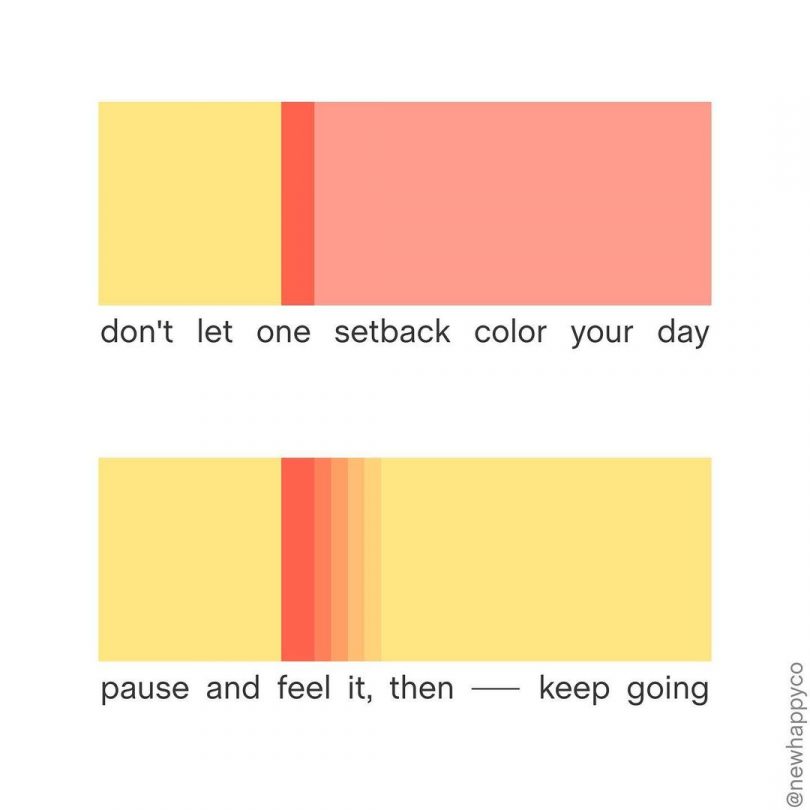The New Happy Turns Research Into Colorful Tools for Wellness
We’re all aware about the detrimental effects social media can have and sometimes it can feel overwhelming to be in this space. Other times, you find little corners of the internet that are full of hope and optimism, and get reminded of all the good things social media can bring. The New Happy is one of them. Founded by Stephanie Harrison, The New Happy is a science-backed, design-forward platform that helps people find lasting happiness. By taking academic studies and original research and translating them into colorful, bite-sized graphics that are easy to understand but encourage inward reflection, Harrison is able to reach a group of people who want/need the help for inner work but perhaps don’t have access to it. She’s creating community, sparking conversation, and encouraging her followers to seek true happiness and wellness, one meaningful Instagram post at a time.
We wanted to know more about Harrison’s creative process and inspiration so we asked her a few questions:
View this post on Instagram
What are the key design principles that guide your organization?
The New Happy has five core design principles that guide everything we do.
The first is to do good. Our philosophy of happiness is grounded in one key idea – we are here to help each other. Everything we make needs to contribute to our collective happiness.
The second is science. Every single piece of content we share is backed by research. We do all of the research so that you don’t have to.
The third is clarity. We use design to clarify and disambiguate this research into messages that are both understandable and useful.
The fourth is simplicity. We communicate these messages in the simplest possible way, across layout, shape, color, and copy.
The final is community. It’s our goal to build a world where we are more connected to each other, and that begins with integrating our community across each platform and delivering messages that encourage connection.
One example of how we’ve integrated these principles is through our weekly newsletter, which 1) Offers one simple and clear science-backed tip to make you happier, 2) Gives you opportunities to feel connected to, share with, and help your fellow community members, and 3) Highlights people using their gifts to serve the world, who we call New Happy Heroes.
Where do you get the inspiration for your content?
The New Happy’s mission is to build a happier world, and we do that by sharing a new, science-backed way to think about happiness. At the highest level, our inspiration always comes from the philosophy of happiness that I’ve spent the last fifteen years developing. It’s the foundation upon which everything is based.
Every one of our platforms is a place to help people, adjusted both for the medium and the messages that are best suited for it. For example, our podcast does a deep-dive into one element of the philosophy and includes actual community members who share their personal stories. Our newsletter gives us a chance to delve into longer-form content, exploring more nuanced ideas. Our artwork offers you bite-size daily tools. Our animations bring these concepts to life through storytelling, and also give you a minute to pause and reconnect to yourself.
Every medium has a different inspiration. For example, Instagram is a visual platform, which is something that we wanted to take advantage of. I was inspired by modern art and Bauhaus, and integrated that with my own intuitive sense about the way that shapes and color can represent emotions, transformations, and happiness. It evolved into our current aesthetic that tries not just to communicate a message through design, but doing it in a simple and beautiful way.
What’s your process for translating this research into a design?
Every piece of content communicates a key idea or insight from the New Happy philosophy. But it’s usually generated by listening to what people in our community need help with. Every week, we ask our community members what problems they’re struggling with or what they want to learn about. Their answers directly inspire the content for the coming days and weeks.
Once we have a general sense of the community’s needs, it kicks off the in-depth design process. I’ll often spend a full day just reading academic papers in order to tease out a core insight – we’re usually bringing together multiple studies to come up with a solution. It’s so important that we give people tools that actually fit into their busy lives. It needs to be useful.
After I have analyzed the research and identified the core insight, that’s when we turn to visual design. We usually start first by sketching up a few ways of visualizing the insight, then choose a favorite to start working on in high fidelity. That then goes through multiple color, layout, and copy iterations through the lens of the design principles, asking questions like, “How can we make this more simple? How can we make this more helpful? Is this message clear?”
Finally, the process concludes with writing the brief essay that goes along with the post, which summarizes the research findings. Then it goes out to the community, right back where it started!
This process varies with the different platforms that we use. For example, we recently launched our first animation series which brings these visuals to life. Our goal was to create these calm, meditative, inspiring moments in your feed. The artwork is just a starting point for the animations – from there, we try to figure out a unique way to animate it and tell a deeper story. That starts with initial concepts, then moves to storyboarding, explorations, and iterations. It really all comes back to the design principles, which guide everything, even down to the music we choose to accompany the animations.
View this post on Instagram
We all know about the pitfalls of social media. Do you think there’s more good than bad when it comes to social media? Can people use social media to meaningfully boost their happiness? If so, why?
It is possible to use social media in a way that supports your well-being. We can’t put that responsibility just on the user, though. We’re immersed in these digital environments that were designed for specific purposes, and that inevitably influences everything we do within them. Platforms have a social responsibility (one that I’d argue is a requirement) to design spaces that promote well-being. As businesses and creators, we also need to be intentional about the kind of space we are creating. To me, there’s a core question to ask ourselves: “Is what I’m creating contributing to collective well-being or detracting from it?”
It’s always been our goal to contribute, and we’ve tried a number of different approaches to deliver on that. For example, we offer monthly programs that are completely free for anyone in our community and delivered on social, teaching people the science of happiness.
One of the programs we did was actually on this very topic: what can we do to use social media to increase our happiness? The key is to think of your social media feed like it’s your digital home. Just like you would in your physical environment, it helps to have goals, routines, and boundaries. If you’re explicit and say, “My digital home is a place that makes me happier,” then a whole host of new behaviors follow from that. You might decide it would make you happier to use it to learn from people who are in similar life situations, or help you develop a new hobby, or work towards a cause that matters to you, or stay in touch with faraway loved ones. If you notice that specific content is not helping you to achieve that goal, you are far more empowered to decide what you want to do about it.
One really interesting insight from the research is that using social media passively is one of the worst things you can do. This is the endless scroll we all know so well, of consuming other people’s content and not engaging, sharing, or connecting. To be happier, we need to lean more into the social side, because very meaningful and important relationships, connections, and communities can be built online. One of the most effective ways we’ve done that is through sharing community members’ stories, challenges, and feelings. It reminds people that they are not alone. We can find this sense of connection on social media, if we use it in authentic and self-expressive ways, and it’s these connections that can have a profound impact on our happiness.
To learn more, follow The New Happy via Instagram, weekly newsletter, and podcast.
from Design MilkDesign Milk https://ift.tt/uDR2hBz






Comments
Post a Comment